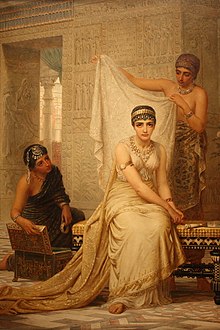
Back Toevoegings tot die boek van Ester Afrikaans Königin Ester ALS أستير Arabic استير ARZ ایستر (کیمسه) AZB Эсфір (дачка Амінавада) Byelorussian Эстэр BE-X-OLD Естир Bulgarian Ester Breton Estera BS
Esther | |
|---|---|
אֶסְתֵּר | |
 Queen Esther (1879) by Edwin Long | |
| Born | Hadassah (הדסה) |
| Title | Queen of Persia and Medes |
| Spouse | Ahasuerus of Persia |
| Parent |
|
Esther,[a] originally Hadassah, is the eponymous heroine of the Book of Esther in the Hebrew Bible. According to the biblical narrative, which is set in the Achaemenid Empire, the Persian king Ahasuerus falls in love with Esther and marries her.[1] His grand vizier Haman is offended by Esther's cousin and guardian Mordecai because of his refusal to bow before him; bowing in front of another person was a prominent gesture of respect in Persian society, but deemed unacceptable by Mordecai, who believes that a Jew should only express submissiveness to God. Consequently, Haman plots to have all of Persia's Jews killed, and eventually convinces Ahasuerus to permit him to do so. However, Esther foils the plan by revealing and decrying Haman's plans to Ahasuerus, who then has Haman executed and grants permission to the Jews to take up arms against their enemies;[2] Esther is hailed for her courage and for working to save the Jewish nation from eradication.
The Book of Esther's story provides the traditional explanation for Purim, a celebratory Jewish holiday that is observed on the Hebrew date on which Haman's order was to go into effect, which is the day that the Jews killed their enemies after Esther exposed Haman's intentions to her husband. Since the 1890s, several academics have “agreed in seeing [The Book of] Esther as a historicized myth or ritual” and generally concluded that Purim is rooted in a Babylonian or Persian myth or festival—though which one is a subject of discussion.[3][4]
Two related forms of the Book of Esther exist: a shorter Biblical Hebrew–sourced version found in Jewish and Protestant Bibles, and a longer Koine Greek–sourced version found in Catholic and Orthodox Bibles.[5]
Cite error: There are <ref group=lower-alpha> tags or {{efn}} templates on this page, but the references will not show without a {{reflist|group=lower-alpha}} template or {{notelist}} template (see the help page).
- ^ Solle 2006, p. 107.
- ^ "Esther 7:2". www.sefaria.org.
- ^ Moore, Carey A. (1971). Esther. Doubleday. See section “The Non-Jewish Origins of Purim.” Pages 46-49. “Esther's canonical status may have been opposed by those Jews who saw the book as a defense for a Jewish festival which, as its very name suggests (*the pûr [that is, the lot]", iii 7; see also ix 26), was non-Jewish in origin. Certainly modern scholars have felt the explanation for Purim's name in ix 26 to be strained and unconvincing. Moreover, the ‘secular" character of the feast suggests a pagan origin, that is, no prayers or sacrifices are specified, but drinking to the point of excess is permitted in the Talmud, Megilla 7b… pûrim is a hebraized form of a Babylonian word...Efforts to identify Purim with an earlier Jewish or Greek festival have been neither common nor convincing, and ever since the 1890s, when Heinrich Zimmern and Peter Jensen equated Mordecai and Esther with the Babylonian gods Marduk and Ishtar, and Haman and Vashti with the Elamite gods Humman and Mashti, a Babylonian origin for Purim has been popular. Though scholars like Jensen, Zimmem, Hugo Winckler, Bruno Meissner and others have each picked a different Babylonian myth or festival as the prototype for Purim, namely, the Gilgamesh Epic, the Babylonian Creation Story, the Tammuz-Ishtar Myth, and the Zagmuk Feast, respectively, they all agreed in seeing Esther as a historicized myth or ritual. More recently, however, a Persian origin for Purim has been gaining support among scholars.”
- ^ Moore, Carey A. “Esther, Book of,” ed. David Noel Freedman, The Anchor Yale Bible Dictionary (New York: Doubleday, 1992), 637-638 “Certainly a pagan origin for Purim would also help to explain the "secular" way in which it was to be celebrated, i.e., with uninhibited and even inebriated behavior (cf. above Meg. 7b). Then too, a pagan origin for the festival would also help to explain the absence of various religious elements in the story…. But even more recently scholars are again looking to Palestine for the origin of the festival… Its Lack of Historicity: [R]are is the 20th-century scholar who accepts the story at face value.”
- ^ Hahn & Mitch 2019, p. 71.
© MMXXIII Rich X Search. We shall prevail. All rights reserved. Rich X Search